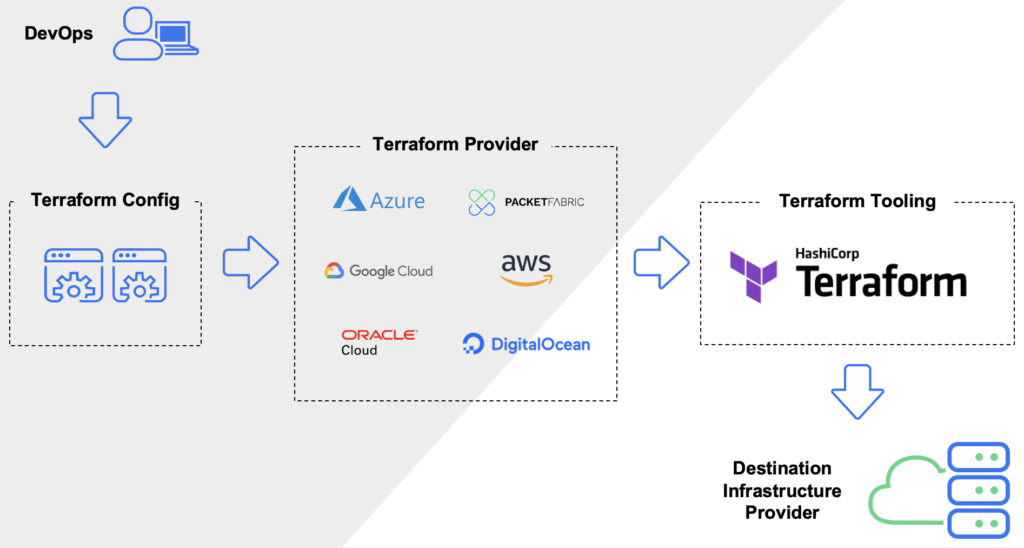Antwort What is the difference between resource and provider in Terraform? Weitere Antworten – What is the purpose of a provider in Terraform
A provider in Terraform is a plugin that enables interaction with an API. This includes Cloud providers and Software-as-a-service providers. The providers are specified in the Terraform configuration code. They tell Terraform which services it needs to interact with.Resources are the most important element in the Terraform language. Each resource block describes one or more infrastructure objects, such as virtual networks, compute instances, or higher-level components such as DNS records. Resource Blocks documents the syntax for declaring resources.Unlike resources, which create and manage infrastructure, data sources retrieve existing data for reference within Terraform configurations.
What is the difference between providers and modules in Terraform : While providers are the conduit to services, Terraform modules are the containers for multiple resources that are used together. They are self-contained packages of Terraform configurations that manage related resources as a single unit.
Can we have 2 providers in Terraform
alias : Multiple Provider Configurations
You can optionally define multiple configurations for the same provider, and select which one to use on a per-resource or per-module basis.
What is the difference between provider TF and main TF : provider.tf – containing the terraform block, s3 backend definition, provider configurations, and aliases. main.tf – containing the resource blocks which define the resources to be created in the target cloud platform. variables.tf – containing the variable declarations used in the resource blocks.
resource : This keyword is used to declare a resource block. "resource_type" : This is the type of resource you want to create. For example, if you're creating an AWS EC2 instance with Terraform, the resource type would be "aws_instance" . "resource_name" : This is a user-defined name for the resource block.
To import a simple resource into Terraform, follow the step-by-step guide below.
- Prepare the EC2 instance.
- Create main.tf and set provider configuration.
- Write config for the resource to be imported.
- Run the import command.
- Observe state files and plan output.
- Improve config to avoid replacement.
Is resource names in Terraform are provider specific
Resource names are nouns, since resource blocks each represent a single object Terraform is managing. Resource names must always start with their containing provider's name followed by an underscore, so a resource from the provider postgresql might be named postgresql_database .Source is a place or person or material from which one can obtain something. Resource is a stock of assets or material which can be used to achieve a goal. 'Information resources' are the information assets of the society, an institution or organization.HashiCorp Terraform now supports more than 3,000 integrations with more than 250 partners, including Amazon Web Services (AWS), Microsoft Azure, Google Cloud, Confluent, Datadog, MongoDB, Palo Alto Networks, ServiceNow, and Zscaler.
alias : Multiple Provider Configurations
You can optionally define multiple configurations for the same provider, and select which one to use on a per-resource or per-module basis.
Do I need main TF in Terraform : Terraform modules must follow the standard module structure. Start every module with a main.tf file, where resources are located by default. In every module, include a README.md file in Markdown format.
What is a resource and give two examples : A resource is a physical material that humans need and value such as land, air, and water. Resources are characterized as renewable or nonrenewable; a renewable resource can replenish itself at the rate it is used, while a nonrenewable resource has a limited supply.
What is an example of a resource
Air, water, food, plants, animals, minerals, metals, and everything else that exists in nature and has utility to mankind is a 'Resource'. The value of each such resource depends on its utility and other factors.
One reason for this is that when you need to rename a resource identifier, and terraform needs to delete the old id and create the new one. This operation would work. If the resource names were the same, the deletion would succeed but the creation would fail on the first apply.By default, Terraform compares your state file to real infrastructure whenever you invoke terraform plan or terraform apply . The refresh updates your state file in-memory to reflect the actual configuration of your infrastructure. This ensures that Terraform determines the correct changes to make to your resources.
Are there 3 types of resources : The 3 main types of resources include human, natural, and capital.








